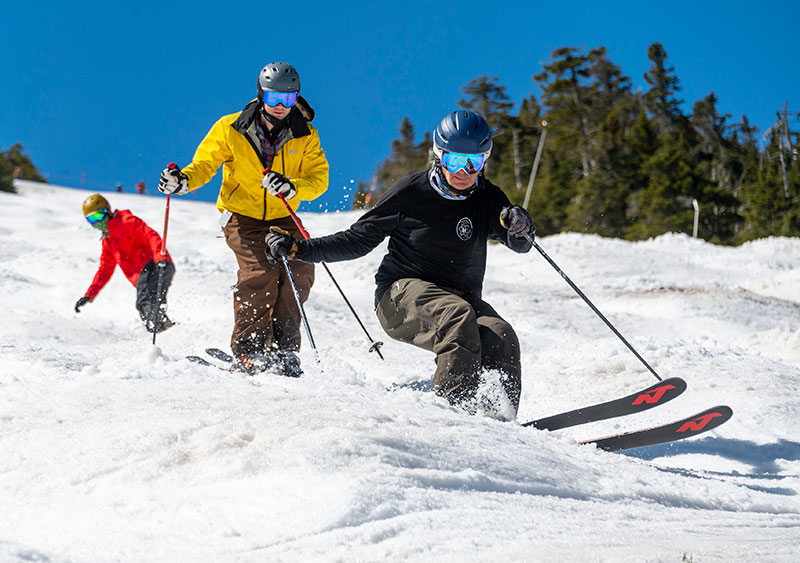You have to ski thin to understand skiing. Piecing together turns from one patch of snow to another patch and watching it all flow downhill, melting away into summer . . .it is over, we all survived another winter. The last turns of the season seem sweeter than any of those that came before. The legs are stronger. The technique has been refined by another season of lessons. The fall lines are more obvious than ever before.
A season spent on the mountain is like the spaces between the notes in music. It is a chance to linger in time, the invisible, silent and yet all powerful wave of time. The attraction of being a ski instructor or any of the underpaid jobs at a ski area is often the attraction of avoidance. It is in some ways about what you are not doing. You are not trapped in an air-conditioned cubicle and scanning spreadsheets. Outside, you are comfortably tucked into layers of warm fleece and overlaid with a branded uniform that sports your name, as well, on the tag. It is a very pleasant environment.
There is just something about a ski area job that holds greater value than money. The psychologist Carl Jung said: “The more stubbornly we believe that all increase has to come from without, the greater becomes our inner poverty.” There are educated and talented grown men and women, many with degrees and advanced degrees, lingering, on the summits, in the folds, in the good graces of mountains. They can be seen loading chairlifts, raking lift pads, chatting on radios, and checking passes. They idle some and linger in the spring sun. They bask in the end of the season’s warm embrace. True wealth is time well spent.
As a ski instructor, I once had a nametag that read: “When the student is ready, the teacher will appear.” It was a comical twist on the Zen axiom. On the right days, I would ski right up to the student at the perfect moment – and off we could go, in search of enlightenment as well as clean arcing turns in the snow. There is nothing exotic about Zen. It is as much homespun New England as it is Oriental. A hard-working farmer who adapts to the vagaries of weather and changing seasons is a Zen master. So is the car mechanic who can hear an engine’s problems simply by listening to it. So isn’t the seeker of the fall line.
Another season of high drama: deep snows, hard ice, and the expansive skies that fall away from our summits. What have we learned? Weather comes and weather goes. There is no bad weather, just inappropriate clothing. My resolve is to always wear that extra layer. I watched young skiers, barely waist high, who are suddenly skating into the fall line of a steep slope! When did that start?
The lessons that are learned from skiing are many and they resonate through other aspects of life if you allow them to. These lessons are best learned at a young age: to conquer fear, to understand the physics of fun, to develop the level of sustained focus that is required for good skiing. On East Coast mountains, a 2,000-foot vertical drop should require two or three minutes of sustained focus to ski non-stop from top to bottom. Anyone should be able to sustain focus for two minutes and 2,000 vertical. If you can concentrate for two minutes, you should be able to concentrate for two hours. The truth is that nobody has to concentrate for more than one second. This one.
There is now nothing but time to prepare for next season. A slackline would go a long way in developing a centered, moving body. It teaches you to use the weight of your outreaching arms to create forward movement and allow for counter balancing. Personally, I found that time on the slackline inexplicably improved my reflexes and eye-hand coordination.
One man made a difference in Mad River Valley skiing that can be seen across the world, on the World Cup circuit. R.I.P. Mr. Al Hobart, who shepherded Green Mountain Valley School into a powerhouse ski academy. RIP, in this man’s case has two meanings: Rest in Peace and “rip,” the core curriculum of GMVS ski racing.







